The iPhone 4 Redux: Analyzing Apple's iOS 4.0.1 Signal Fix & Antenna Issue
by Brian Klug & Anand Lal Shimpi on July 15, 2010 12:28 PM EST- Posted in
- Smartphones
- Apple
- iOS 4
- iPhone 4
- Mobile
Better at the Low End, Mixed Feelings Everywhere Else
Brian came up with the plan to enable the numerical signal strength visualization and executed on it very well in our original iPhone 4 review. Since then there’s been a disturbing amount of debate as to whether or not this actually amounts to a problem with the phone.
Part of the confusion stems from the fact that doing this sort of antenna testing in a real world scenario is time intensive. As Brian mentioned on the previous page, for today’s article both of us were driving around our respective cities, stopping at various locations, measuring signal strength and comparing it to bar mappings in order to produce the charts you saw on the other page.
There’s no denying that Apple has played a significant role in why there continues to be debate about the iPhone 4 antenna. By simply addressing the pre-4.0.1 bars not being a good representation of signal strength and ignoring the fact that the iPhone 4 does lose more signal strength than competing phones depending on how you hold it, Apple manages to convince its faithful that there’s nothing wrong while driving its critics to demand a recall.
My mother always taught me that honesty is the best policy and presumably I’m not the only one in the world who was privy to this information. Had Apple come clean with both of these facts (the bar mapping and the signal attenuation issue) early on we’d be in a far more clear cut world today.
We have consistently argued that the 4’s antenna is a design choice by Apple. As we’ve seen in our testing there are situations where the iPhone 4’s antenna makes things better (e.g. holding onto calls with very low signal strength) and other situations where the design makes them worse (e.g. holding it wrong in situations with low signal strength). I wanted to describe the inconsistency in greater detail so I went out with an iPhone 3GS and 4 and documented my experiences.
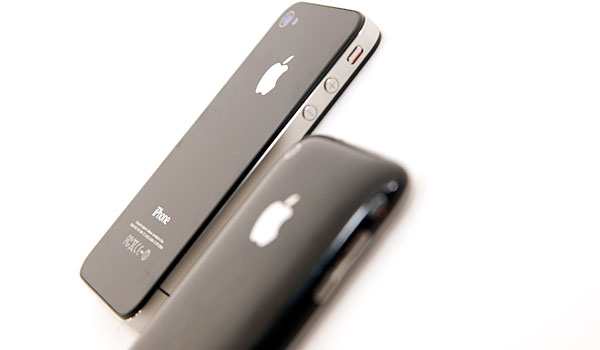
In practice I found three things that were true about the iPhone 4’s antenna behavior compared to the 3GS.
Reception in average conditions is sometimes significantly better on the iPhone 4 than on the 3GS. Take a look at the image capture below. In the same exact location we have better reception on the 4 than the 3GS. Granted this could be due to a number of variables outside of the phone’s antenna itself, but it happened enough times that it’s worth reporting. This is the positive to Apple’s external antenna design - you can and do get better reception. Unfortunately the tradeoff is the scenario I just described before this.
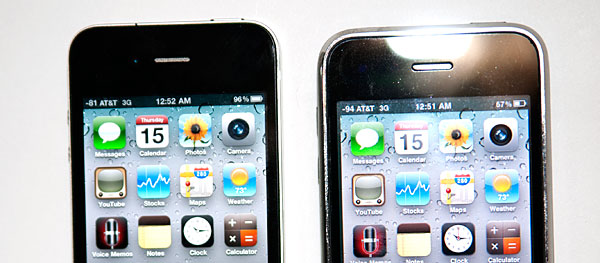
iPhone 4 (left) at -81 dBm vs. iPhone 3GS (right) at -94 dBm
Signal strength is sometimes the same as or worse than the iPhone 3GS. This is really where the problem comes into play. In the shot below I have the 4 and 3GS sitting next to one another and they are displaying roughly the same signal strength. We’ve already proven that holding the iPhone 4 attenuates its signal more than the 3GS, which results in the frustration we’ve seen expressed by many at this point. In situations where the 4 has the same signal as the 3GS, holding the phone is going to drop it to levels significantly worse than the 3GS. If you’re in an area with low signal strength to begin with, holding the phone is going to bring you down to dangerously low levels.
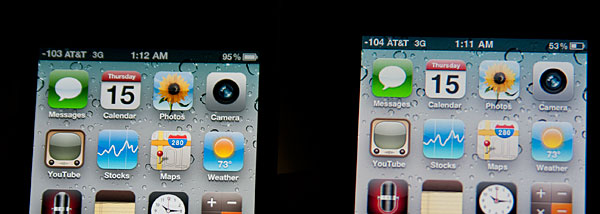
iPhone 4 (left) at -103 dBm vs. iPhone 3GS (right) at -104 dBm
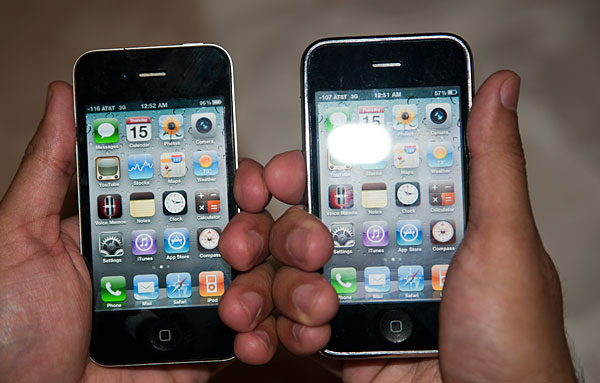
iPhone 4 being held tightly (left) at -115 dBm vs. iPhone 3GS being held tightly (right) at -107 dBm
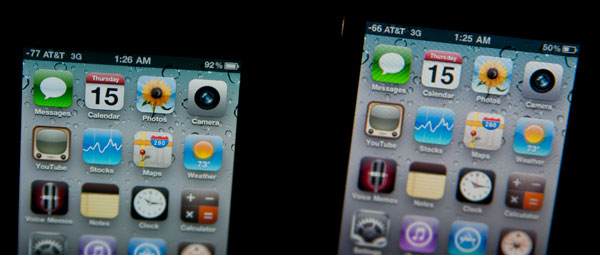
iPhone 4 (left) at -77 dBm vs. iPhone 3GS (right) at -66 dBm
The iPhone 4 is better at holding onto calls and data at very low signal levels. We’ve mentioned this one before but it’s worth reiterating. The new antenna does let me make calls and transmit data at very low signal strength. With the iOS 4.0.1 update I was able to make a call at -115dB on the 3GS, however the call did drop within a minute of starting it. By comparison I was able to have a much longer conversation without dropping the call at -120dB on the 4. By no means is this a scientific comparison, but anecdotally both Brian and I feel that the low signal strength performance of the iPhone 4 is better than the 3GS.

A call at -120 dBm on the iPhone 4
If you’re keeping tabs you’ll note that this is what is traditionally referred to as a trade off. Apple opted for good performance in low signal situations (and style of course) over maintaining consistently better or unchanged radio performance compared to the 3GS. I would personally consider this to be an unnecessarily risky design choice, particularly for a smartphone vendor. Note that it's nearly impossible to separate out the antenna from the rest of the iPhone 4 platform to determine exactly what is responsible for the phone's signal sensitivity in various situations. All we ultimately know is how physically interacting with the antenna impacts reported signal strength.
I can’t stress enough that this issue impacts all users. The variability is in how strong of a signal you have to begin with. That’s the absolute only reason there’s debate in these discussions from phone to phone. At my desk I don’t get great reception on AT&T. With the iPhone 4 I’m usually at -96dBm. If I keep a tight grip on the phone or if I’m holding it to send text messages I can sometimes lose all signal entirely. This is a combination of poor reception at my house and the fact that the 4 loses more of its signal than other phones when held certain ways.
Brian on the other hand has much better reception at his home. To him, the signal strength drops but it does not drop enough for this to be a problem. I consider myself to be on the border. If I’m mindful of how I’m holding the phone it’s not an issue, and even most of the time if I’m not paying attention to it it’s not an issue. However there are definitely times when it does become a problem. I wouldn’t consider it to be the majority of the time or even more than 10% of the time, but it happens enough for me to have to think about it. Ultimately this is why I consider Apple’s design here to be unnecessarily risky. Introducing a change with stylistic and technical benefits where the downside is limited but potentially very noticeable is just ballsy.
Luckily for Apple, there are things that can be done about it.










146 Comments
View All Comments
screensurfer - Saturday, July 17, 2010 - link
No. Care to explain? It's not my words, it's his (something like this): "we haven't found a solution to defy the laws of physics. YET!", i.e., after September 30th we'll have a different antenna system that doesn't drop calls so easilybarelyinaudible - Saturday, July 17, 2010 - link
I keep seeing this article quoted as "proof" to apple's signal problem. However, I am finding that you are leaving out one rather important piece of information -- Your reference.Are you measuring in dBc, dBJ, dBm, dBi, dBd, dBq? There are literally hundreds of different reference points to choose from?
Also, dB is a logarithmic function - What is starting point for the attenuation? 100 dB? 30 dB?
Going from 120 - 100 dB is a MUCH MUCH bigger drop than from 30 - 10 dB -- since dB increases exponentially.
I think this article is being intellectually dishonest by not providing proper information to your readers (read: 85% of statistics are made up on the spot.)
ameridian - Saturday, July 17, 2010 - link
There are 22 occurrences in this article referrings to dBm's as the unit of measure. I'd advise reading the article before posting comments.leeseng - Saturday, July 17, 2010 - link
Hi anand,Full tight grip is about tight grip with another palm cover up the phone as well. That's very similar to how a tight-grip-fellow talking over the phone call.
I just did a test. Full-tight-grip cost -24dBm in my htc desire. Where as tight grip cost -12dBm. What about iPhone4?
rushbc - Saturday, July 17, 2010 - link
my favorite quote from the article is this one:"Ultimately this is why I consider Apple’s design here to be unnecessarily risky. Introducing a change with stylistic and technical benefits where the downside is limited but potentially very noticeable is just ballsy."
i agree and would like to add the following:
so is creating and mass-producing a $700 smartphone out of glass!!
that is pure Steve Jobs "balls to the wall, damn the torpedos, full speed ahead, F 'em if they don't like it" ballsy. love ya, Steve (and J.Ive), but you guys may be a little too aggressive sometimes in your design decisions.
i love my iphone 4, it's great, it's fast, it's beautiful, it works super for ALL of my needs--yes even phone calling/signal strength is great--but i am in constant fear of dropping it. dropping a $700 piece of glass would suck, because, guess what? glass breaks when you drop it!
...but try not dropping something that you carry around with you every single day, wherever you go, and are constantly using it throughout each day, picking it up, putting it down, taking it out of pocket, putting it back in pocket, etc. not an easy task....it requires constant care and vigilance to not drop the darn thing. and yes, glass can be slippery, so theres that, too.
love the phone, hate the stress!
Griswold - Saturday, July 17, 2010 - link
Get one of the free bumpers. It would be the first I'd do with a glass sandwich like that.ajb - Saturday, July 17, 2010 - link
I notice that in the photos of the iPhone 4 compared to the 3GS you were holding the iPhone 4 in your left hand (presumably having much more contact with the sensitive area of the antenna aray) while the photo of the 3GS depicts you holding the phone in your right hand. Could this have resulted in whole or in part for the larger drop of signal strength with the iPhone 4? Trust me, I'm not trying to defend the iPhone 4 - I've had enough problems of my own with maintaining a signal. I only ask to make sure that the numbers quoted are accurate.Also, I have noticed a very discernable difference in wi-fi performance at the weak end of the wi-fi bar scale (2 out of 3 wi-fi bars). My 3GS did much better in performance than does my 4. I sometimes get the impression that the phone's alogorithm at that wif-fi signal strength can't make up its mind whether it wants to be on 3G or wi-fi, which even with 2 bars should be and with the 3GS always was much faster than 3G. I do believe I read somewhere that there might be a problem with not releasing expired IP addresses, but I don't think that accounts for all of the problems I have been having because even after turning off wi-fi, moving closer to my wireless router, turning wi-fi back and, and walking back to where I originally was, I continue to experience the problem. Have you done any wi-fi testing? Do you have any insights into this problem? Any idea if this is a wide-spread problem?
codeachrome - Saturday, July 17, 2010 - link
Try KaptonTape.comanandreader - Sunday, July 18, 2010 - link
Brian-Could you clarify what you did there?
I'd like to enable dBm instead of bars on my iPhone.
Thanks!
Fri13 - Sunday, July 18, 2010 - link
"While the software update obviously does not and cannot address the design of the antenna itself - or make the drop from holding the phone any less - it does change the way the issue is perceived among users. "Actually the algorithm should effect the reception. The firmware (where the algorithm is placed) is responsible to use more or less power (W) to boost the signal what phone antenna is receiving. I have heard that max output is 2W. With 1W boost you gain -30dB.
While the bars tells the signal strength from cellphone to tover, the algorithm needs to compensate the drop/rise of the signal strength so it would not drop off. So if the max drop of is -24dB and before the iOS 4.0.1 the 1-4 bars were merely calculating -22dB range before drop out, the boost was never enough to keep the cellphone in the network (like you had -22dB signal, you touched and you got -24dB drop and algorithm boosted only -15dB, you were -7dB over the needed signal strength).
As anandtech has noted, software can not affect the hardware itself. The software can not eliminate the -24dB drop what is coming from hand (and touch). But the software can make the drop smaller by boosting the signal to needed level.
What is the needed level? Stronger signal = bigger power consuming -> less talk time / stand-by time. Needed level is simply that what gives good enough voice quality and keeps data transfer at maximum. It is not wise to overrun the power use so the battery is empty more faster.
And do people remember when Apple did improve the battery life in the 3Gs time with software patch? That would be very easy to do just by making the signal boost algorithm such that it does not use so much power = weaker boosting.